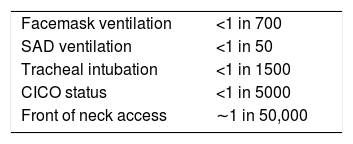Airway management is an essential area in anaesthesia, and anaesthesiologists are considered the most expert professionals to manage airway tasks. However, complications related to inadequate airway management remain the most frequent cause of morbidity and mortality.
Algorithmic strategy to solve difficulties fails, due to several factors related to its structure and clinical application.
The Vortex Approach has emerged as a response to the limitations found in the algorithmic strategy of managing the difficult airway, by using a cognitive aid strategy to reduce cognitive load and fixation error. This new strategy may represent a solution to the elusive problem of the challenging airway and reduce the complications rate.
El aislamiento de la vía aérea es un área esencial en la anestesia. Los anestesiólogos se consideran los profesionales más expertos para resolver cualquier problema relacionado con una vía aérea difícil. Sin embargo, las complicaciones derivadas del manejo incorrecto de la vía aérea siguen siendo una de las causas más frecuentes de morbimortalidad asociada a la anestesia.
La estrategia mediante algoritmos de tratamiento para resolver estas dificultades ha demostrado su fracaso debido a varios factores relacionados con su estructura y su aplicación clínica.
El enfoque Vortex surge como una respuesta a las limitaciones encontradas en los algoritmos de manejo de una vía aérea difícil, utilizando una estrategia de ayudas para reducir la carga cognitiva y el error de fijación. Esta nueva estrategia puede representar una solución al problema de la dificultad de la vía aérea y, poder así, reducir la incidencia de complicaciones.










